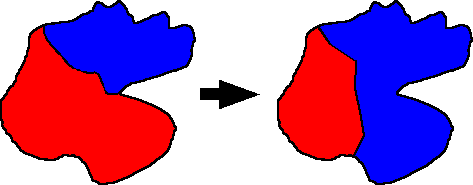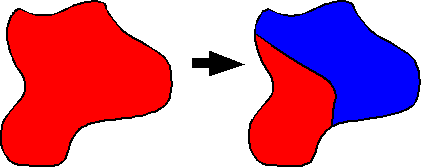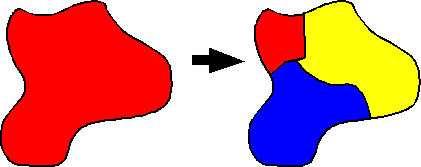Forms of NPA Relief
When a Numbering Plan Area (NPA, or area code) gets close to reaching its full capacity of telephone numbers, it is said to be in jeopardy. If it reaches capacity, so that it is no longer possible to assign new prefixes, it is said to have exhausted. This condition is likely to result in delays in providing new service, simply because there are no telephone numbers available to assign. Thus, before an area code exhausts, various state/provincial and federal regulators meet with industry representatives and interested members of the general public to formulate a plan for relief. [Note: since 1999 in Canada, and since 2007 in the United States, all NPA relief has been in the form of general-services NPA overlays.]
NPA Realignment

In a realignment, a portion of one NPA is moved into an adjacent NPA. This technique does not provide significant long-term relief, since it simply shifts the problem over. However, it may be used in conjunction with other techniques. For instance, area code 916 in northern California split in November 1997. Rather than split into the new area code, however, the city of Dixon asked to be realigned into the adjacent 707 area code, since Dixon is the only community in Solano County that was not already in 707. Since Dixon had only two prefixes, neither of them previously in use in 707, and since 707 was not near jeopardy, this realignment was approved.
NPA Split

In an NPA split, the traditional form of NPA relief, a portion of an existing NPA is given a new NPA, with a new geographic boundary separating the two. All existing numbers in the split area must change to the new area code. There is usually a “permissive dialing” period during which numbers in the split area may be reached using either the old or the new area code. Once the split becomes mandatory, however, dialing a number in the split area by using the old area code will either reach an intercept recording, or reach a wrong number once the prefix is reassigned in the old area code.
3-way NPA Split

This relief plan is a simple variation on the traditional geographic split. The only difference is that two new area codes are introduced simultaneously (or within a short time span). This method of relief was used in 1997 for area code 206 in Washington and area codes 817 and 210 in Texas.
Overlay

An overlay is a relatively new concept in area code relief. In its simplest form, known as a “general services overlay,” a new area code is introduced into exactly the same geographic territory currently served by an existing area code. New prefixes from the new area code are assigned right alongside existing prefixes in the old area code. Existing numbers do not change. However, to minimize customer confusion, all calls within an overlay area — even local calls within the same area code — must be dialed with the area code. Also, the possibility exists that two phone lines in the same building may have different area codes. This form of relief was used in 1997 for both area codes in Maryland. Although there was significant public resistance to the idea initially, general-services overlays have become the standard method of area code relief.
Once an overlay is instituted in a given geographic area, any further expansion is accomplished simply by adding further overlay area codes to the same territory. That means that no numbers need to be changed, and political fights about drawing the boundaries for ever-smaller geographic splits can be permanently avoided.
Variations on the overlay theme include a single overlay that covers more than one existing area code with the new area code. In 1998, Georgia instituted area code 678 as an overlay on both the 404 and 770 area codes in the Atlanta area. In a sense, this move created a three-way overlay in the single 404/678/770 area. In a “service-specific” overlay, one or more types of telephone service — for example, all pagers and cellular phones — in an existing area code are moved to the new overlay code. The FCC has ruled that “service-specific” overlays may not be used in the U.S., with the exception that the wireless overlay area code 917 in New York City was grandfathered, although there are now also landline numbers in 917. In a phased overlay, one type of service is assigned numbers from the overlay area code before other types of service, but eventually the overlay area code is used for all services. It is also possible to combine elements of these types of overlay: in 1995, Illinois originally planned area code 630 as a service-specific overlay on both area codes 312 and 708 (the area now covered by 312, 630, 708, 773, and 847), before changing it to multiple geographic splits.
Another variation on the overlay is the “concentrated” overlay, the method chosen for area code 305 in southern Florida. Area code 305 served the Miami/Dade County metropolitan area and also the Florida Keys. The Keys remained only in area code 305, while the Miami/Dade portion of 305 was overlaid with 786. [The Keys subsequently joined in the 305 & 786 overlay. Since 2008, there are no concentrated overlays in service or planned.]
In a boundary elimination overlay, a previous area code split is retroactively converted to an overlay. The two existing area codes now serve the entire reunited geographic area. In 1998, downtown Los Angeles split area code 213, with only a small part of the core of downtown keeping 213 while the “donut” around it changed to 323. In 2017, the California Public Utilities Commission ordered a boundary elimination overlay, so both the inner and outer downtown areas are now in area codes 213 & 323. (Downtown Los Angeles added 738 as an overlay on .) There have also been boundary elimination overlays in San Diego and Dallas; Houston officially performed a boundary elimination overlay of 713 & 281, but both old codes were nearly full and a third code (832) was added at the same time, so in effect it was just a multiple overlay.
Florida came up with yet another variation on the overlay, something of a reverse of the concentrated overlay, which I refer to as a Double-Back-Somersault Reverse Concentrated Overlay with a Twist, although that name understates the complexity of the plan. In phase 1 of the DBSRCOT, a portion of the existing area code 407 (the “Space Coast” area) split off geographically to a new area code, 321. In phase 2, the part that retained the original area code in the split, the Orlando area, was overlaid with the same new area code 321. In 2019, the Orlando area was overlaid with area code 689; the Space Coast is still just area code 321 — although they had to convert to 10‑digit local calling anyway because of “The Big 10D.” To date, no other state has been silly enough to propose a DBSRCOT.
An intriguing variation on the concentrated overlay is the so-called “spotted cow” overlay. In a spotted cow, an entire area code is overlaid with a second area code, but any rate center which has only one prefix is allowed to retain 7‑digit dialing, effectively excluding it from the overlay. No spotted cows have yet been planned or implemented.
| Multiple Overlay | Concentrated Overlay | |
|---|---|---|

|

|
|
| Boundary Elimination Overlay | ||

|
||
| Double-Back-Somersault ReverseConcentrated Overlay with a Twist | ||

|
||
| “Spotted Cow” Overlay | ||

|
||
